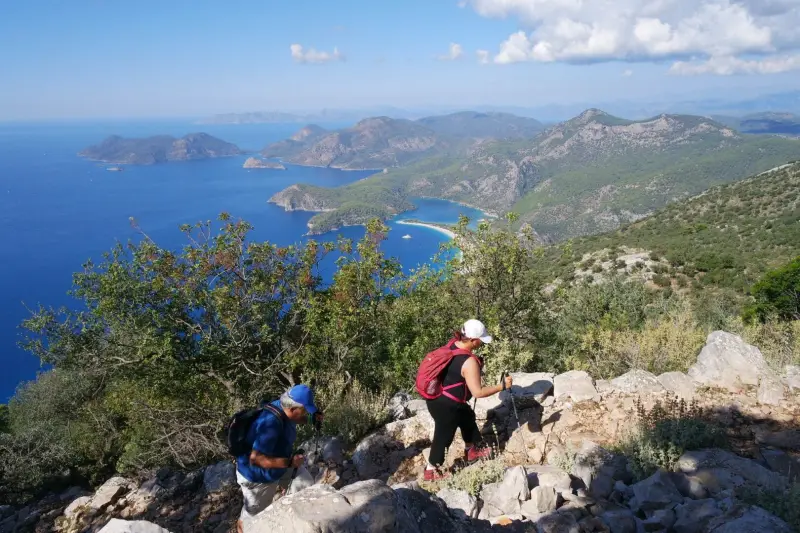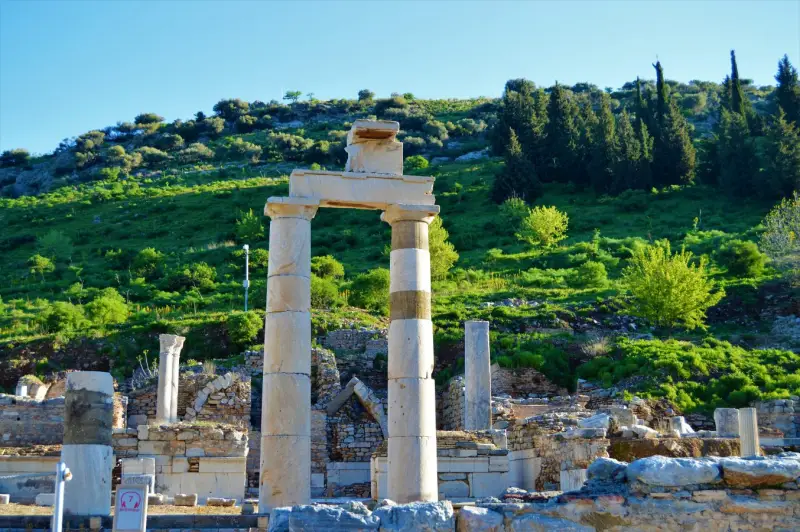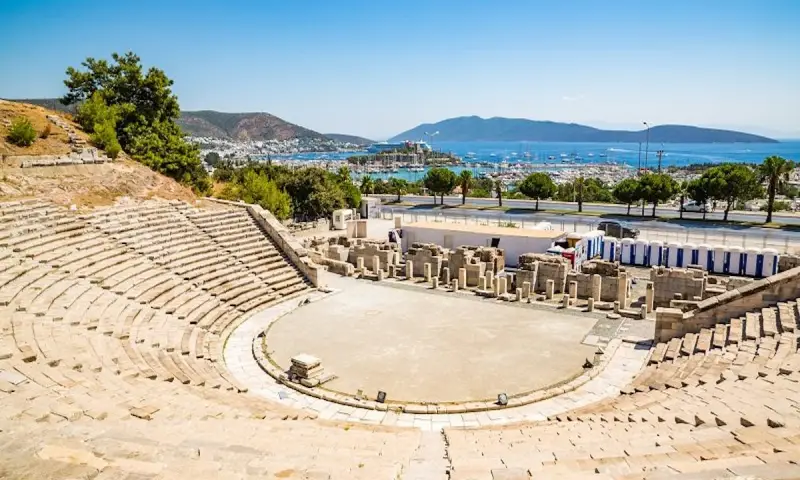The Lycian Way: A Step Back in Time Amidst Turkey’s Breathtaking Landscapes
Greetings, fellow travelers! Today, I’m whisking you away on an unforgettable journey along the Lycian Way, a 500km trek that meanders through the heart of southwestern Turkey. Brimming with ancient history and awe-inspiring landscapes, the Lycian Way is a haven for the ardent hiker, the history buff, and the nature enthusiast. So, tighten your laces, fill up your water bottle, and let’s set off on this extraordinary adventure together!
The Allure of the Lycian Way
The Lycian Way is no ordinary hiking trail. As Turkey’s first long-distance footpath, it traverses a rich tapestry of terrain, stretching from the bustling city of Fethiye to the sun-drenched coastal town of Antalya. Named after the ancient civilization of Lycia that once flourished here, the trail offers a unique blend of striking coastal and mountain landscapes, punctuated by ruins that whisper tales of a bygone era.
Every step along the Lycian Way is a step back in time. Walking this path, you’ll find yourself in the footsteps of ancient Lycians, Romans, and Ottomans, each civilization having left its indelible mark on this captivating landscape. From the remnants of grand amphitheaters to the eerie tranquility of deserted towns, the Lycian Way is a living museum of the world’s past.
Planning for the Adventure
An adventure on the Lycian Way requires careful planning. I embarked on my journey in the coolness of early spring – arguably the best time to explore the trail. The weather is mild, the trail is peppered with blooming wildflowers, and there are fewer hikers on the path.
Packing for this trip was a task in itself. In my backpack, among other essentials, were a reliable map of the Lycian Way, a sturdy water bottle, plenty of sun protection, a comprehensive first aid kit, a lightweight camping stove, a warm sleeping bag, and a weather-resistant tent. Each of these items proved invaluable at different stages of the journey.
Setting Off: Fethiye to Oludeniz
Our journey began in the vibrant city of Fethiye, known for its ancient rock tombs, including the impressive Tomb of Amyntas. As we left the city behind, the trail led us through lush pine forests and along steep cliffs, revealing stunning vistas of the Mediterranean Sea.
Our first stop was Oludeniz, a small village famed for its blue lagoon. The sight of the turquoise water contrasted with the white sandy beach was a welcome reward after the day’s trek. We set up camp here, lulled to sleep by the gentle sound of waves lapping against the shore.
Oludeniz to Faralya: The Butterfly Valley
The next stretch of the journey took us to Faralya, a quaint village perched on cliffs overlooking the sea. En route, we descended into Butterfly Valley, a secluded paradise accessible only by boat or via the Lycian Way. The valley, home to diverse butterfly species, is a nature lover’s dream. We spent hours marveling at these beautiful creatures before resuming our journey to Faralya.
Hike into the Wilderness
The trail from Faralya to Kabak led us deep into the wilderness, with dense forests and rugged terrain. The sweet scent of pine trees filled the air as we made our way along the trail. The highlight of this stretch was reaching the remote village of Kabak. It is a perfect spot to set up camp and spend the night. We enjoyed a refreshing dip in the pristine waters of Kabak Beach, followed by a delicious meal at a local eatery.
Kabak to Patara: Ancient Ruins and Golden Sands
Leaving Kabak behind, we trekked towards Patara, one of the most historically significant stops along the Lycian Way. This ancient city was once the capital of the Lycian League and is now an archaeological site boasting a wealth of ruins. Exploring the remains of the Roman-era theater, the baths, and the impressive Arch of Modestus left us in awe of the city’s former grandeur.
After immersing ourselves in history, we arrived at Patara Beach, Turkey’s longest stretch of sand. We set up camp near the beach and spent the evening watching the sun set over the golden sands.
Patara to Kalkan: Coastal Splendor
From Patara, we ventured on to the charming coastal town of Kalkan. This stretch of the trail offered breathtaking views of the Mediterranean coastline, with azure waters and rugged cliffs dominating the landscape. The picturesque town of Kalkan, with its whitewashed houses and vibrant bougainvillea, was the perfect place to unwind and enjoy a well-deserved break.
Kalkan to Kas: The Ancient City of Xanthos
The journey from Kalkan to Kas took us through some of the most striking landscapes on the Lycian Way. Along the way, we visited the ancient city of Xanthos, a UNESCO World Heritage Site and the former capital of ancient Lycia. Here, we marveled at the intricately carved tombs, inscriptions, and the remnants of the city’s acropolis.
Continuing on, we reached the bustling town of Kas, a lively destination brimming with history, culture, and a vibrant nightlife. We spent the night here, enjoying the warm hospitality of the locals.
Kas to Demre: The Legend of St. Nicholas
The trail from Kas to Demre brought us to the heart of the Teke Peninsula. The path weaved through ancient olive groves and fragrant citrus orchards, eventually leading us to the town of Demre. Here, we visited the Church of St. Nicholas, the historical figure who inspired the legend of Santa Claus. Exploring this ancient church and its surrounding ruins was a fascinating experience that added depth to our understanding of the region’s past.
Demre to Finike: The Wild Beauty of Cape Gelidonya
As we trekked from Demre to Finike, we traversed the wild beauty of Cape Gelidonya, a remote and rugged stretch of coastline. The terrain was challenging, but the views of the Mediterranean Sea and the distant mountains were worth every step. Eventually, we reached the coastal town of Finike, where we enjoyed a well-earned rest and a delicious seafood dinner.
Finike to Antalya: The Final Stretch
The final stretch of our journey took us from Finike to Antalya, the trail’s end. We passed through quaint villages, verdant valleys, and lush forests, each step bringing us closer to the end of our adventure. As we arrived in Antalya, we were filled with a sense of accomplishment
The difficulty of the Lycian Way can vary significantly depending on the specific sections of the trail you choose to trek, your physical fitness level, your hiking experience, and the time of year you decide to hike.
Spanning over 500 kilometers, the Lycian Way is a long-distance trail that includes a mixture of coastal paths, forest trails, rocky terrains, and mountainous areas. Some parts of the trail require steep ascents and descents, which can be challenging for inexperienced hikers or those with lower fitness levels.
In terms of technical difficulty, the Lycian Way is not considered a technical hike (it doesn’t require special climbing skills or equipment), but certain sections can be rugged and rocky, which could prove challenging if you’re not used to conditions.
The weather can also influence the difficulty of the Lycian Way. During the summer months, the high temperatures can make hiking strenuous and potentially dangerous due to the risk of heat exhaustion or heat stroke. Conversely, during the winter, some parts of the trail can be cold and wet, making them slippery and harder to navigate. Therefore, spring and autumn are often considered the best times to hike the Lycian Way, when the weather is milder and more comfortable for hiking.
It’s also worth noting that the Lycian Way is a self-guided trail, meaning you’ll need to navigate yourself using trail markers, maps, or GPS. This can add an extra layer of difficulty if you’re not an experienced hiker or if you’re not comfortable with navigation.
The Last Words
While the Lycian Way can be a challenging hike due to its length, terrain, and weather conditions, it’s also an incredibly rewarding adventure that offers stunning landscapes, rich history, and a unique opportunity to immerse yourself in the natural beauty of Turkey. As always, preparation is key: ensure you have the right equipment, train adequately for the hike, and make sure to stay safe and respect the environment.
How long does it take to hike the Lycian Way?
The Lycian Way is a roughly 540 kilometer long trail, spanning from the city of Fethiye to Antalya in southwestern Turkey. Given its length, the time it takes to hike the entire trail can greatly vary depending on several factors:
- Pace: A person’s average hiking speed can depend on their physical fitness, load carried, and terrain. On average, a fit and experienced hiker might cover around 20-25 kilometers a day on mixed terrain.
- Rest days: It’s important to consider rest days, especially on a long trek like the Lycian Way. These can be used to recuperate, explore towns along the trail, or wait out bad weather.
- Sightseeing: Part of the appeal of the Lycian Way is the wealth of historical and cultural sites along the route. Spending time to visit these sites will add to the overall time it takes to complete the trail.
Considering these factors, hiking the entire Lycian Way might typically take somewhere between 3 to 6 weeks. Some people might choose to do it in less time if they are particularly fast hikers. Others might choose to take it slower, savoring the journey and taking more time to explore the surroundings. As always, it’s essential to plan according to your own abilities, interests, and time constraints.
Remember that it’s also possible to hike just sections of the Lycian Way if you don’t have the time or desire to complete the whole trail. The trail is conveniently segmented, and many sections can be completed as standalone day hikes or multi-day treks.
Can you do the Lycian Way without camping?
Yes, it is possible to hike the Lycian Way without camping. The trail passes through many towns and villages where you can find guesthouses, small hotels, and pensions offering accommodation. Often, these places will also provide meals, or there will be local restaurants and markets where you can get food.
It’s important to plan your daily hikes to ensure you end up in a location with available accommodation each night. Some sections of the Lycian Way are more remote, so you’ll want to plan accordingly.
However, do note that availability can vary depending on the season, and some places may be booked up in advance during the peak tourist seasons. Therefore, it’s a good idea to book your accommodation in advance whenever possible, especially if you’re hiking during the busy season.
Having said that, even if you don’t plan to camp, it’s a good idea to bring some essential camping gear, like a lightweight sleeping bag or emergency bivvy. This is just a precaution in case you find yourself in a situation where you can’t reach your planned accommodation.
Keep in mind that while you can hike the Lycian Way without camping, one of the attractions of a long-distance hike like this is the opportunity to camp in beautiful natural locations. If you’re open to the idea of camping at least part of the time, it could add a lot to your experience on the Lycian Way.
Is the Lycian trail safe?
Yes, the Lycian Way is generally considered safe, but like any outdoor activity, especially long-distance hiking, it does come with certain inherent risks and challenges. Here are a few things to consider:
1. Terrain and Physical Challenges: The Lycian Way covers various types of terrain, including steep, rocky areas, forests, and coastal paths. Some sections of the trail can be physically demanding and potentially hazardous, especially if you’re not well-prepared or in good physical condition.
2. Navigation: The Lycian Way is marked, but signs and waymarks can sometimes be missing or unclear, particularly in more remote areas. It’s a good idea to have a map or a GPS device with you, and know how to use them.
3. Weather: Weather conditions can change quickly, and extreme weather can make hiking dangerous. This is particularly true in the summer months when temperatures can get very high, and heat exhaustion can be a risk.
4. Wildlife: While encounters with dangerous wildlife are rare, the trail is home to a variety of animals. It’s best to know how to respond should you encounter any wildlife.
5. Remote Areas: Some sections of the Lycian Way are quite remote, which could be a challenge in case of an emergency. It’s a good idea to let someone know your plans and check-in regularly.
6. Local Laws and Customs: Always respect local laws and customs. This is especially important in rural areas and when visiting historical and cultural sites.
7. Health and Hygiene: Ensure you have access to clean water and understand how to maintain personal hygiene on the trail to avoid illness.
What Month Is Best for Lycian Way?
The best months to hike the Lycian Way are typically in the spring and autumn when the weather is milder. This generally means April to June and September to November.
During these months, the temperatures are cooler, making for more comfortable hiking conditions. In the spring, the landscape is particularly beautiful with wildflowers blooming. While in the autumn, the temperatures are pleasant and the summer crowds have thinned out.
The summer months (July and August) can be extremely hot, which can make hiking uncomfortable and potentially dangerous due to the risk of heat exhaustion. In contrast, the winter months can be cold and wet, particularly in the mountains, which can make the trails slippery and more challenging.
However, it’s essential to keep in mind that weather can be unpredictable, and conditions can vary from year to year. Therefore, it’s always a good idea to check the weather forecast and trail conditions before setting off on your hike.
What should I pack for the Lycian Way?
Packing for the Lycian Way requires careful planning, as you’ll need to balance between having everything you need and keeping your pack as light as possible. Here are some essential items you might want to consider:
1. Hiking Gear:
- Good quality, broken-in hiking boots or shoes.
- Lightweight hiking clothes, including a waterproof jacket and pants.
- Hat, sunglasses, and sunscreen for protection against the sun.
- Warm layers for the cooler evenings or higher altitudes.
2. Navigation and Safety:
- A detailed map and/or a guidebook of the Lycian Way.
- A compass or GPS device.
- A headlamp or flashlight with extra batteries.
- A basic first aid kit.
- A whistle for emergency signalling.
3. Food and Water:
- Water bottles or a hydration bladder.
- Water purification tablets or a water filter.
- High-energy snacks for the trail.
- If you plan on cooking, a lightweight stove and cooking equipment.
4. Shelter and Comfort:
- If you’re camping, a lightweight tent, sleeping bag, and sleeping mat.
- Travel towel and toiletries.
- Insect repellent.
- Earplugs can be useful if you’re a light sleeper.
5. Miscellaneous:
- Mobile phone and charger. Consider a portable power bank.
- Camera, if you wish to take photos.
- Small binoculars for wildlife watching.
- Plastic bags for carrying out your trash.
Remember to pack light, as carrying too much weight can make hiking difficult and less enjoyable. It’s also worth checking the weather forecast before you leave, so you can pack appropriately for the expected conditions.
Finally, always let someone know your hiking plans and check-in regularly. Safety should be your top priority when hiking on the Lycian Way or any other trail.
The Ancient Sites You Will See on Lycian Way
The Lycian Way trail offers a rich tapestry of ancient sites, ruins, and cities from the Lycian civilization. Here are some of the notable ancient sites you’ll encounter while hiking the Lycian Way:
1. Fethiye: The starting point of the trail is the city of Fethiye, which has a fascinating Lycian rock tomb, the Tomb of Amyntas, carved into the cliffs overlooking the town.
2. Patara: Once a major naval and trading port, Patara is home to an impressive collection of ruins, including a theatre, baths, and a parliament building. Patara is also famous for its stunning beach.
3. Xanthos: Recognized as a UNESCO World Heritage Site, Xanthos was the capital city of Lycia. Here you’ll find a variety of ruins, including tombs, an acropolis, and a Roman theatre.
4. Letoon: Close to Xanthos, Letoon was a significant religious sanctuary and is also part of the UNESCO site. You’ll find temples dedicated to the goddess Leto and her twin offspring, Apollo and Artemis.
5. Pinara: Known for its unique Lycian rock tombs carved into a cliff face, Pinara is a fascinating site to explore.
6. Tlos: One of the oldest inhabited sites in Lycia, Tlos boasts an acropolis, Roman stadium, and striking rock tombs.
7. Olympos: Famous for its treehouse accommodations, Olympos is also home to a spread-out ancient site right by the sea, with ruins that include a theatre, baths, and a necropolis.
8. Phaselis: An ancient Lycian city with three separate harbors, Phaselis is located within a national park and has beautiful coastal views.
9. Simena (Kaleköy): Only accessible by boat or on foot, Simena is home to a medieval castle with stunning views and ancient Lycian sarcophagi scattered throughout the village.
You can check the weather conditions on this site.






